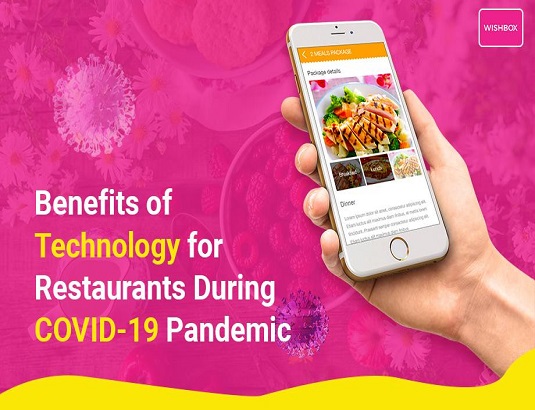In terms of how we exist, interact with each other, and conduct daily business, Coronavirus has changed many aspects. Owners are looking for creative technology to help protect their clients and workers as closures continue to affect the restaurant and entertainment industries.
While most of the globe continues to struggle with the COVID-19 threat, the expectation is that things will return to a new kind of normal eventually. To restore public confidence, restaurateurs would need to implement proper safety measures within their establishments before venturing to reopen for business.
We would expect the COVID-19 pandemic to respond similarly. To remain ahead of the curve, Wishbox is receptive to technological developments and innovations will effectively overcome problems created by the current situation.
Some innovations are helpful for restaurants during COVID-19, in addition to maintaining social distancing protocols such as spacing out the high bar stool chairs and limiting customer capacity.
Nevertheless, restaurants taking early steps to reopen are charged with improving their sanitation beyond the already stringent requirements, and in those efforts, technology will play a critical role.
Let’s take a look at some of the technologies at the end of the pandemic that could soon become part of your daily operations.
- Inventory Management:
Restaurant inventory management technology is there to help with the safety and protection of your food. You can monitor the freshness of your food with this technology, and work to guarantee only the freshest ingredients. So far, much of the available data confirm the continued durability of the food delivery apps during the pandemic. With that in mind, you can decide not only the freshness of your product but how long the journey from agriculture to front-of-house can be supported by tracking instruments.
Suggested– 7 Top Trends Food Delivery Start-ups You Cannot Ignore In 2020
You can trace the source of your ingredients by using an inventory management system and prevent food theft. When surveying the news, you can use the data from your inventory management protocols to pick a new supplier, probably something locally sourced, and farm-to-table if you determine any danger from any specific suppliers.
- Back to House:
Your kitchen, which provides the rest of your restaurant with what it needs to thrive, whether on or off-premise, is the heart of any restaurant. The back-of-house service (BOH) is always hectic, with workers hustling to meet both incoming and outgoing orders. A kitchen display system (KDS) that eliminates the clutter of paper tickets, while increasing efficiency in order accuracy, is the most popular BOH technology. Although BOH tech aims to streamline food preparation, sanitation efforts will be improved by several critical functions.
- Bin Management:
The idea behind a KDS system is to show your BOH employees what orders are expected and how far these orders are in progress. This implies that the workers have to make quick and efficient decisions to concentrate on the task at hand, the fast preparation of food. But in your kitchen, there is plenty of other work to be done, including cooking and cleaning activities that can often fall on the wayside.
Join bin control, which is a device designed to alert the workers at the right time to drop food products. You can configure bin management features to remind you to regularly drop fresh ingredients to ensure the best available items and to eliminate any possible disease vectors, CV-19 based or otherwise.
- Data Analytics:
Data analytics, like your bin management, is a feature of many KDS systems and offers you the ability to evaluate your performance. You will decide what products are marketed through data analytics to determine what works and what does. You may also set peak hours of operation in the sense of restaurant food safety, which is ever-evolving as we experience the pandemic. Knowing the company’s ebbs and flows, you can assess methods to clean and sanitize the overall flow of the activities effectively.
- Recipe Viewers:
Another option is to use recipe viewer technology as a training guide inside your KDS. Recently, the pandemic has caused about two-thirds of all restaurant and hospitality workers to lose their jobs. While several may be recalled after reopening begins, new staff members are likely to be required. A recipe viewer will provide a vital guide to both the consistency of your food and the proper preparation of each item to prevent contamination.
Some recipe viewer technologies make it possible for operators to provide staff tips and notes. You can program recipe viewers to populate messages that remind workers when and how to clean or sanitize properly, much like bin management protocols. Reopening rules can vary from place to place, so you can use a recipe viewer to apply recall schedules for sanitation, trash takeout, wipe down station, and more based on the unique reopening conditions.
- Restaurant Management Tech:
Restaurant management platforms are usually used to help arrange incoming guests to settle their checks from their arrival in the system. An immediate advantage of restaurant management technology is that the total number of guests can be phased, as many places have limited the maximum capacity of restaurants and other shared spaces.
Restaurant management platforms are usually used to help arrange incoming guests to settle their checks from their arrival in the system. An immediate advantage of restaurant management technology is that the total number of guests can be phased, as many places have limited the maximum capacity of restaurants and other shared spaces.
Conclusion:
If we have learned something from previous crises that is that such a tragedy has always been accompanied by some of the greatest developments and revolutionary technological opportunities. This is because, to solve big losses, organizations are forced to reinvent existing structures and expand innovative responses.






